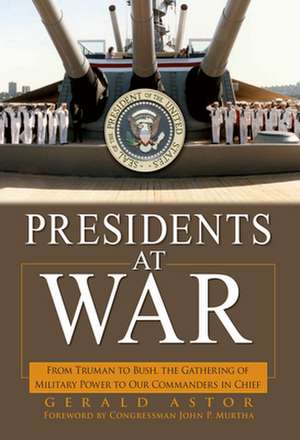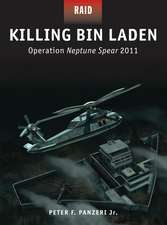Presidents at War: From Truman to Bush, the Gathering of Military Powers to Our Commanders in Chief
Autor Gerald Astor John P. Murthaen Limba Engleză Hardback – 7 sep 2006
Presidents at War is the first book to examine all of America′s post–World War II military actions through the lens of the president′s authority as commander in chief. Author Gerald Astor analyzes the various presidents′ rationales for undeclared warfare, from Truman′s citing of an international agreement (the United Nations) to Eisenhower′s domino theory, to Kennedy′s defense of the Monroe Doctrine, to bald assertions of authority by a commander in chief because of fears of communist expansion, threats to oil in the Middle East, humanitarian concerns in the Balkans, or provocations by terrorists. Each commander in chief served as a precedent for those who followed. Astor contends this cumulative process was accelerated by the September 11, 2001, attacks that led to the war on terrorism, the invasion of Iraq to oust the cruel regime of Saddam Hussein for his alleged possession of weapons of mass destruction, and the potential trampling of civil liberties in the United States.
Has the president become free to take military action on the slightest whim? Is it now true that, as Richard Nixon said, "If the president does it, then it is not illegal"? Is the Constitution obsolete? And does Congress have the tools with which to curb this seemingly unbridled power? Read Presidents at War and find out.
Preț: 187.60 lei
Nou
Puncte Express: 281
Preț estimativ în valută:
35.90€ • 37.25$ • 30.01£
35.90€ • 37.25$ • 30.01£
Carte disponibilă
Livrare economică 22 februarie-08 martie
Preluare comenzi: 021 569.72.76
Specificații
ISBN-13: 9780471696551
ISBN-10: 0471696552
Pagini: 320
Dimensiuni: 166 x 237 x 30 mm
Greutate: 0.64 kg
Editura: Wiley
Locul publicării:Hoboken, United States
ISBN-10: 0471696552
Pagini: 320
Dimensiuni: 166 x 237 x 30 mm
Greutate: 0.64 kg
Editura: Wiley
Locul publicării:Hoboken, United States
Public țintă
Readers interested in the intersections of military history and US presidential power such as the Korean and Vietnam Wars, the wars against Iraq and the Cuban Missile Crisis.Descriere
The Korean War, the Bay of Pigs, the Cuban Missile Crisis, Vietnam, Cambodia, Lebanon, El Salvador, Grenada, Iran–Contra, Nicaragua, Panama, the Gulf War, Somalia, Kosovo, Afghanistan, Iraq What do these events and scores of others have in common? Each of these wars, incursions, invasions, and covert actions was undertaken by the United States without the benefit of a declaration of war. Where congressional sanction was sought, it usually took the form of a resolution, frequently issued after the fact.
Presidents at War is the first book to examine all of America′s post World War II military actions through the lens of the president′s authority as commander in chief. Author Gerald Astor analyzes the various presidents′ rationales for undeclared warfare, from Truman′s citing of an international agreement (the United Nations) to Eisenhower′s domino theory, to Kennedy′s defense of the Monroe Doctrine, to bald assertions of authority by a commander in chief because of fears of communist expansion, threats to oil in the Middle East, humanitarian concerns in the Balkans, or provocations by terrorists. Each commander in chief served as a precedent for those who followed. Astor contends this cumulative process was accelerated by the September 11, 2001, attacks that led to the war on terrorism, the invasion of Iraq to oust the cruel regime of Saddam Hussein for his alleged possession of weapons of mass destruction, and the potential trampling of civil liberties in the United States.
Has the president become free to take military action on the slightest whim? Is it now true that, as Richard Nixon said, "If the president does it, then it is not illegal"? Is the Constitution obsolete? And does Congress have the tools with which to curb this seemingly unbridled power? Read Presidents at War and find out.
Presidents at War is the first book to examine all of America′s post World War II military actions through the lens of the president′s authority as commander in chief. Author Gerald Astor analyzes the various presidents′ rationales for undeclared warfare, from Truman′s citing of an international agreement (the United Nations) to Eisenhower′s domino theory, to Kennedy′s defense of the Monroe Doctrine, to bald assertions of authority by a commander in chief because of fears of communist expansion, threats to oil in the Middle East, humanitarian concerns in the Balkans, or provocations by terrorists. Each commander in chief served as a precedent for those who followed. Astor contends this cumulative process was accelerated by the September 11, 2001, attacks that led to the war on terrorism, the invasion of Iraq to oust the cruel regime of Saddam Hussein for his alleged possession of weapons of mass destruction, and the potential trampling of civil liberties in the United States.
Has the president become free to take military action on the slightest whim? Is it now true that, as Richard Nixon said, "If the president does it, then it is not illegal"? Is the Constitution obsolete? And does Congress have the tools with which to curb this seemingly unbridled power? Read Presidents at War and find out.
Textul de pe ultima copertă
The Korean War, the Bay of Pigs, the Cuban Missile Crisis, Vietnam, Cambodia, Lebanon, El Salvador, Grenada, Iran–Contra, Nicaragua, Panama, the Gulf War, Somalia, Kosovo, Afghanistan, Iraq What do these events and scores of others have in common? Each of these wars, incursions, invasions, and covert actions was undertaken by the United States without the benefit of a declaration of war. Where congressional sanction was sought, it usually took the form of a resolution, frequently issued after the fact.
Presidents at War is the first book to examine all of America′s post World War II military actions through the lens of the president′s authority as commander in chief. Author Gerald Astor analyzes the various presidents′ rationales for undeclared warfare, from Truman′s citing of an international agreement (the United Nations) to Eisenhower′s domino theory, to Kennedy′s defense of the Monroe Doctrine, to bald assertions of authority by a commander in chief because of fears of communist expansion, threats to oil in the Middle East, humanitarian concerns in the Balkans, or provocations by terrorists. Each commander in chief served as a precedent for those who followed. Astor contends this cumulative process was accelerated by the September 11, 2001, attacks that led to the war on terrorism, the invasion of Iraq to oust the cruel regime of Saddam Hussein for his alleged possession of weapons of mass destruction, and the potential trampling of civil liberties in the United States.
Has the president become free to take military action on the slightest whim? Is it now true that, as Richard Nixon said, "If the president does it, then it is not illegal"? Is the Constitution obsolete? And does Congress have the tools with which to curb this seemingly unbridled power? Read Presidents at War and find out.
Presidents at War is the first book to examine all of America′s post World War II military actions through the lens of the president′s authority as commander in chief. Author Gerald Astor analyzes the various presidents′ rationales for undeclared warfare, from Truman′s citing of an international agreement (the United Nations) to Eisenhower′s domino theory, to Kennedy′s defense of the Monroe Doctrine, to bald assertions of authority by a commander in chief because of fears of communist expansion, threats to oil in the Middle East, humanitarian concerns in the Balkans, or provocations by terrorists. Each commander in chief served as a precedent for those who followed. Astor contends this cumulative process was accelerated by the September 11, 2001, attacks that led to the war on terrorism, the invasion of Iraq to oust the cruel regime of Saddam Hussein for his alleged possession of weapons of mass destruction, and the potential trampling of civil liberties in the United States.
Has the president become free to take military action on the slightest whim? Is it now true that, as Richard Nixon said, "If the president does it, then it is not illegal"? Is the Constitution obsolete? And does Congress have the tools with which to curb this seemingly unbridled power? Read Presidents at War and find out.
Cuprins
Foreword by Congressman John P. Murtha. Acknowledgments.
Introduction: Commander in Chief.
1 The Evolution of War Powers and Precedents.
2 World War I, World War II.
3 The Truman Years.
4 The Reign of Ike.
5 Camelot s Commander in Chief.
6 The Missile Crisis.
7 Resolution and Reverberations.
8 LBJ, Part of the Way.
9 Down the Slope.
10 Toward Peace with Honor.
11 Pieces of Peace.
12 The Bitter End.
13 Iran, Afghanistan, and Lebanon.
14 Beirut, Central America, and Iran.
15 Iran–Contra.
16 Bush One.
17 Nation–Building and Genocide.
18 Prevention and Retaliation.
19 Between Iraq and Hard Places.
20 Winning the War, Fighting On.
21 Power and Abdication.
Notes.
Bibliography.
Index.
Introduction: Commander in Chief.
1 The Evolution of War Powers and Precedents.
2 World War I, World War II.
3 The Truman Years.
4 The Reign of Ike.
5 Camelot s Commander in Chief.
6 The Missile Crisis.
7 Resolution and Reverberations.
8 LBJ, Part of the Way.
9 Down the Slope.
10 Toward Peace with Honor.
11 Pieces of Peace.
12 The Bitter End.
13 Iran, Afghanistan, and Lebanon.
14 Beirut, Central America, and Iran.
15 Iran–Contra.
16 Bush One.
17 Nation–Building and Genocide.
18 Prevention and Retaliation.
19 Between Iraq and Hard Places.
20 Winning the War, Fighting On.
21 Power and Abdication.
Notes.
Bibliography.
Index.
Notă biografică
A former magazine writer and editor, GERALD ASTOR has published twenty–four books, twelve on World War II, including The Jungle War: Mavericks, Marauders, and Madmen in the China–Burma–India Theater of World War II, also available from Wiley. He lives in Scarsdale, New York.









